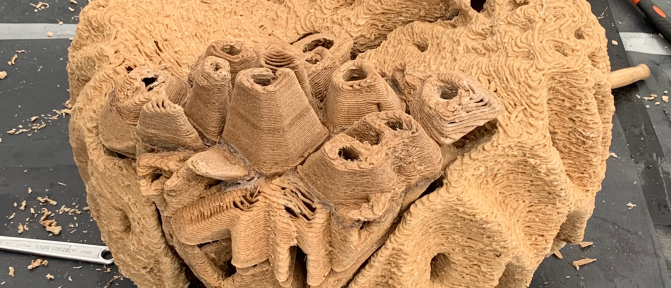Stimulating biodiversity in 3D printed bio-cyber physical 'planetoids'
Tool robots have a short but rich history in architecture, including materials research and new construction techniques. Researchers Henriette Bier and Pierre Oskam, with a team of landscape architects, architects, and roboticists, are creating bio-cyber-physical capsules called 'planetoids' in the Robotic Building lab.
These planetoids have multiple cavities and small spaces, providing biotopes for plants, insects and small animals to literally breathe new life into these spaces. This project aims to make interventions that benefit existing life in urban residual spaces. And thus encourage autonomous development, especially in terms of biodiversity and water retention. The asteroids are accessible to passers-by or neighbours to visit the asteroids, water them and, if necessary, move them to places with less sun or wind depending on the data, collected via sensors accessible via an app, on the respective microclimates.

The planetoid
The planetoid is being constructed using robotic 3D printing technology. The planetoid prototype is printed from a wood-based biopolymer. The project is a collaboration between Complex Projects of the Architecture department and Landscape Architecture of the Urbanism department.
More information
Complex Projects' researchers Henriette Bier, Arwin Hidding and Max Latour and Pierre Oskam of Landscape Architecture are working with academic and industrial partners such as UniFri, 3D Robot Printing, and Tokencube. See more information here.
Opening soon in Sydney is the exhibition The SHErobots: Tool, Toy, Companion, which addresses questions about the nature and processes of contemporary robotics through the lens of female perspectives. Henriette Bier will be part of this exhibition in Sydney with her 'planetoid'. This exhibition is co-sponsored by the Dutch Ministry of Foreign Affairs, through the Embassy of the Kingdom of the Netherlands, Australia and TU Delft, Robotics Institute, Netherlands.